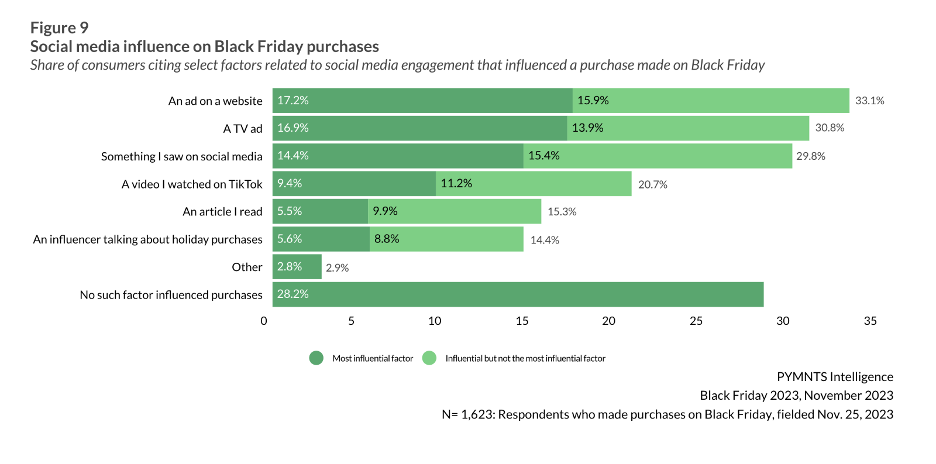From Slump to Surge, Ads and Influencers Revive Black Friday

Despite the price hikes that threatened the Black Friday spirit, 2023 saw shoppers rising to the occasion with a 10% surge in participation compared to 2020. But who were the true “price-fighters” behind this boost? Try good old advertisements, influencers and retail media.
In fact, according to recent data from “Black Friday 2023: Consumers Widen Their Search for Holiday Bargains,” drawing from a Nov. 25 survey of 2,691 consumers, 7 out of 10 shoppers acknowledge that advertisements, influencers and media played a significant role in influencing their purchasing decisions.
Delving deeper into this data, PYMNTS found 28% of consumers said media had no impact on their buying decisions. Meanwhile, one-third of shoppers acknowledged the influence of website advertising, with 17% regarding it as the primary factor guiding their Black Friday purchases. Additionally, TV advertising closely followed, influencing 31% of consumers, with 17% of this group identifying it as the foremost influence.
Social media played a role too, with 30% of consumers recognizing its impact on their Black Friday buying decisions, and 14% specifically highlighting social media as the most crucial influencer.
Why Social Media and Ads Resonate During Stressful Times
Inflation often prompts consumers to become more discerning in their spending habits, and this is where effective advertising becomes a game-changer. Well-crafted advertisements not only serve as a platform for showcasing products but, more importantly, they can communicate value and address the evolving needs and concerns of consumers in times of economic uncertainty. The ability of advertisements to offer compelling narratives and solutions becomes crucial, influencing purchasing decisions and giving consumers a sense of confidence in their choices.

Enter influencers, the modern-day word-of-mouth marketers. As social media platforms continue to dominate the consumer landscape, influencers wield considerable power in shaping opinions and preferences. Their authenticity and relatability resonate with audiences, creating a sense of trust that traditional advertising often struggles to achieve.
During times of inflation, where cautious spending is the norm, the endorsement of a trusted influencer can tip the scales in favor of a purchase. Influencers provide a bridge between brands and consumers, offering a more personalized and genuine connection that is increasingly valuable in a world saturated with advertisements.
Now, let’s layer in the holiday season — a time when consumer spending traditionally peaks and sprinkle in some inflation. During this time consumers want to find the perfect gifts for loved ones but battle the limitations of the wallets and inflation. That’s where brands and retailers look to advertising and influencers, leveraging their power to inspire consumers to open their wallets and spend despite the challenges posed by financial limitations and inflationary pressures.
How Amazon and Walmart Are Leveraging These Influences
These are the retail tactics employed by industry titans such as Amazon and Walmart to encourage more consumer spending.
For example, in an interview with PYMNTS, Oliver Messenger, Amazon’s shopping director, discussed the growing emphasis on facilitating content creators and everyday consumers in sharing their preferred products. He emphasized that the motivation behind this initiative is rooted in the fact that “Every day, customers turn to their communities to gather shopping inspiration and advice.”
Keeping that in consideration, Amazon introduced “Consult-a-Friend” to recognize the importance of friends and family advice in the decision-making process for a customer’s purchases.
“Often, we see customers turn to Amazon influencers and reviews to get the insights they are looking for, but we also know input from friends and family is key for a lot of shoppers when they are making a purchasing decision,” Messenger said.
To utilize Consult-a-Friend, shoppers can tap the Share button and locate the “Ask for your friends’ votes” option. From there, they can choose their preferred messaging app and select the recipients they want to send the request to.
“We believe the trend of social shopping will only continue to grow, so we’re investing in experiences that make it easy for customers to connect with and learn from each other — whether that be from friends and family or a broader community of influencers and customers that share the same interests,” Messenger told PYMNTS.
See also: Amazon Shopping Director on the Power of Friends With Influence
Meanwhile, Walmart broadened its shoppable TV presence through a recent collaboration with NBCUniversal’s Peacock platform.
The partnership allows enthusiasts of “Below Deck Mediterranean,” a reality series following the crew of a super-yacht, to purchase products inspired by the show during “shoppable episodes” scheduled for broadcast on Nov. 7, Dec. 5 and Dec. 12.
“When customers find something they love during an ad break, they can simply press arrows on the remote to browse the interactive onscreen product carousel and scan a QR code to easily checkout on Walmart.com,” Walmart said in a statement.
According to Walmart, the collaboration stems from the fusion of Walmart’s eCommerce capabilities and NBCUniversal’s artificial intelligence (AI) technology, capable of identifying objects within a scene of the show.
Read more: Walmart Strengthens TV-eCommerce Connection With Peacock Partnership
The Black Friday Turnout
Black Friday 2023 experienced a 10% uptick in participation, but consumers devoted only a fifth of their holiday shopping to this occasion. While 53% made purchases, it represented just 20% of their intended holiday expenditure.
Post-Christmas shopping saw a rise to 14%, while in-store-only Black Friday shopping decreased to 16%. Despite a third of participants encountering stock shortages, concerns diminished compared to the previous year.
On average, consumers spent $533, with pay later users exhibiting a 48% increase in spending. Three in 10 spent less than the prior year, and Gen Z engagement declined to 75%, with 46% perceiving inferior deals. The perception among Gen Z in the diminishing significance of Black Friday doubled, potentially influencing their decreased turnout.



